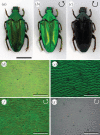Circularly polarized reflection from the scarab beetle Chalcothea smaragdina: light scattering by a dual photonic structure
- PMID: 28630672
- PMCID: PMC5474034
- DOI: 10.1098/rsfs.2016.0129
Circularly polarized reflection from the scarab beetle Chalcothea smaragdina: light scattering by a dual photonic structure
Abstract
Helicoidal architectures comprising various polysaccharides, such as chitin and cellulose, have been reported in biological systems. In some cases, these architectures exhibit stunning optical properties analogous to ordered cholesteric liquid crystal phases. In this work, we characterize the circularly polarized reflectance and optical scattering from the cuticle of the beetle Chalcothea smaragdina (Coleoptera: Scarabaeidae: Cetoniinae) using optical experiments, simulations and structural analysis. The selective reflection of left-handed circularly polarized light is attributed to a Bouligand-type helicoidal morphology within the beetle's exocuticle. Using electron microscopy to inform electromagnetic simulations of this anisotropic stratified medium, the inextricable connection between the colour appearance of C. smaragdina and the periodicity of its helicoidal rotation is shown. A close agreement between the model and the measured reflectance spectra is obtained. In addition, the elytral surface of C. smaragdina possesses a blazed diffraction grating-like surface structure, which affects the diffuse appearance of the beetle's reflected colour, and therefore potentially enhances crypsis among the dense foliage of its rainforest habitat.
Keywords: Bouligand structure; Coleoptera; blazed grating; circular polarization.
Conflict of interest statement
We declare we have no competing interests.
Figures





Similar articles
-
Pitch profile across the cuticle of the scarab beetle Cotinis mutabilis determined by analysis of Mueller matrix measurements.R Soc Open Sci. 2018 Dec 5;5(12):181096. doi: 10.1098/rsos.181096. eCollection 2018 Dec. R Soc Open Sci. 2018. PMID: 30662728 Free PMC article.
-
Optically ambidextrous circularly polarized reflection from the chiral cuticle of the scarab beetle Chrysina resplendens.J R Soc Interface. 2017 Jun;14(131):20170129. doi: 10.1098/rsif.2017.0129. J R Soc Interface. 2017. PMID: 28615493 Free PMC article.
-
No evidence for behavioral responses to circularly polarized light in four scarab beetle species with circularly polarizing exocuticle.Physiol Behav. 2012 Feb 28;105(4):1067-75. doi: 10.1016/j.physbeh.2011.11.020. Epub 2011 Dec 1. Physiol Behav. 2012. PMID: 22155007
-
Experimental degradation of helicoidal photonic nanostructures in scarab beetles (Coleoptera: Scarabaeidae): implications for the identification of circularly polarizing cuticle in the fossil record.J R Soc Interface. 2018 Nov 14;15(148):20180560. doi: 10.1098/rsif.2018.0560. J R Soc Interface. 2018. PMID: 30429263 Free PMC article.
-
Cholesteric liquid crystals with a broad light reflection band.Adv Mater. 2012 Dec 11;24(47):6260-76. doi: 10.1002/adma.201202913. Epub 2012 Oct 23. Adv Mater. 2012. PMID: 23090724 Review.
Cited by
-
Multi-scaled regulation for cholesteric organization of cellulose nanocrystals based on internal and external factors.Nanoscale Adv. 2024 Oct 30;6(24):6061-6078. doi: 10.1039/d4na00700j. eCollection 2024 Dec 3. Nanoscale Adv. 2024. PMID: 39569334 Free PMC article. Review.
-
When nanocellulose meets diffraction grating: freestanding photonic paper with programmable optical coupling.Mater Horiz. 2020 Feb 1;7(2):511-519. doi: 10.1039/c9mh01485c. Epub 2019 Oct 2. Mater Horiz. 2020. PMID: 32774862 Free PMC article.
-
Pitch profile across the cuticle of the scarab beetle Cotinis mutabilis determined by analysis of Mueller matrix measurements.R Soc Open Sci. 2018 Dec 5;5(12):181096. doi: 10.1098/rsos.181096. eCollection 2018 Dec. R Soc Open Sci. 2018. PMID: 30662728 Free PMC article.
-
Single chip simultaneous chiral and achiral imaging based on high efficiency 3D plasmonic metalens.Nanophotonics. 2023 Jul 10;12(16):3243-3255. doi: 10.1515/nanoph-2023-0142. eCollection 2023 Aug. Nanophotonics. 2023. PMID: 39634147 Free PMC article.
References
-
- Thompson DW. 1961. On growth and form. Cambridge, UK: Cambridge University Press.
-
- Turing AM. 1952. The chemical basis of morphogenesis. Phil. Trans. R. Soc. B 237, 37–72. (10.1098/rstb.1952.0012) - DOI
-
- Neville AC. 1993. Biology of fibrous composites. Cambridge, UK: Cambridge University Press.
LinkOut - more resources
Full Text Sources
Other Literature Sources

